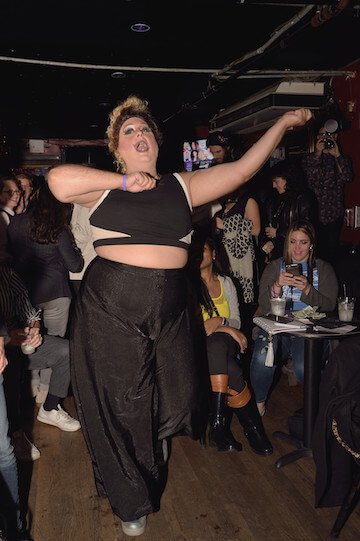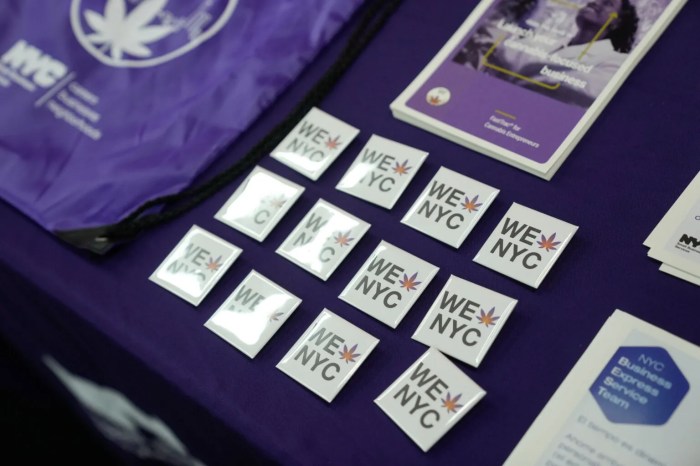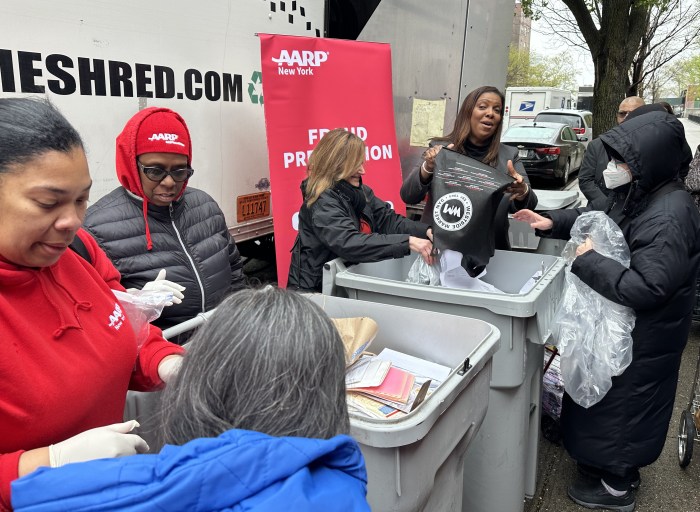The celebration outside the Stonewall on June 24, 2011, the day New York's marriage equality law was enacted. | DONNA ACETO
The New York City Landmarks Preservation Commission (LPC) will, next week, begin consideration of landmark designation for the Stonewall Inn in Greenwich Village, site of the Stonewall Rebellion of 1969 that sparked the modern LGBT rights movement, Gay City News has learned.
If approved, it would represent the first such designation from the Commission bestowed exclusively for a site’s significance to the LBGT community.
At its June 2 meeting, the Commission will consider whether to schedule a public hearing at a subsequent meeting that would likely follow soon. That hearing would provide opportunity for comment from experts and the public.
In a written statement to Gay City News, Meenakshi Srinivasan, the LPC chair, said, “The Stonewall Inn is widely known as the birthplace of the modern LGBT rights movement and holds a truly iconic place in history. In addition to its cultural importance, the building still retains its architectural integrity from its period of significance during the Stonewall Rebellion. I am proud to bring the Stonewall Inn before the full Commission to be considered for designation as an individual and official landmark of New York City –– a worthy site that symbolizes one of the most important events in LGBT history for not only New York City, but for the entire country. Recommending Stonewall Inn’s designation represents the Landmark Preservation Commission’s commitment to honor New York’s unique and diverse cultural, social, and political heritage.”
Local public officials and the Greenwich Village Society for Historic Preservation have been pressing for the designation for years — with increased urgency recently given the Rebellion’s impending 50th anniversary in 2019. A press conference by GVSHP, elected officials including US Representative Jerrold Nadler and Borough President Gale Brewer, and the Empire State Pride Agenda had been scheduled for June 1 outside the Stonewall to call for landmark designation for the bar as well as other sites –– including Julius’ Bar at 159 West 10th Street, where gay people won the right to be served alcohol in 1966; the LGBT Community Center at 208 West 13th Street, where ACT UP and many other community groups were born; and the site of the Gay Activists Alliance (GAA) Firehouse at 99 Wooster Street, the first significant gay community center in New York.
That press conference has now been cancelled.
The Commission has been researching the Stonewall designation for some time and was unaware of the scheduled press conference.
Out gay City Councilmember Corey Johnson, whose district includes the Stonewall, said in reaction to the development, “Wow! It’s shocking that in 2015 the Stonewall Inn was never recognized as an individual landmark given its hugely important symbolism and history. LPC recognition is stronger than federal or state recognition. It brings with it more protection.”
The designation would apply only to the exterior of the Stonewall. For a time after the bar closed in the 1970s, a bagel shop and pottery store occupied the spaces before a bar resumed operating in one of the storefronts. While the new bar appears to be thriving, there has been discussion in recent years of its possible use as a national LGBT history museum.
Out gay State Senator Brad Hoylman, whose district also takes in the Stonewall and has, as well, pressed for the designation for years, said, “The landmarks law has not permitted buildings that have cultural significance but minimal architectural or aesthetic significance to be individual landmarks. I am pleased to see the shift in how landmarks will be considered generally and that it is starting with Stonewall, which is a human rights icon across the globe.”
Hoylman said he would also like to see it designated by executive order as a National Park by President Barack Obama, who mentioned Stonewall along with Seneca Falls and Selma as sites of three great human rights struggles in his 2013 Inaugural Address. Seneca Falls, New York, is part of the Women’s Rights National Historic Park, and the Edmund Pettus Bridge in Selma is a US National Historic Landmark.
The street outside the bar, where the Rebellion lasted for several days and nights in June of 1969, was named Stonewall Place by the city in 1989. A George Segal sculpture of gay and lesbian couples called “Gay Liberation” in Christopher Park across the street was dedicated in 1992. The Stonewall Inn is on the National Register of Historic Places and is listed on the New York State Register of Historic Places.
But the city had previously balked at individual landmark status since it is already within the Greenwich Village Historic District, which was designated in April of 1969, two months before the Stonewall made history. The historic district designation report creating the district, as a result, makes no mention of the Rebellion. Landmark designation for it now would preserve those architectural features it possessed in June of 1969.
GVSHP's Berman, who spearheaded the landmarking fight for years, called the latest development “fantastic news,” “incredibly important,” and “long overdue.” The site, he said, got its federal historic recognition “in 1999 in response to an application from GVSHP and others.”
Berman said that the Stonewall’s interior is not up for landmark status since it has been modified since 1969.
“But we don’t want it to become a Starbucks or a nail salon,” he said. “We and others are looking to make sure that it remains a place that speaks to the history of the LGBT rights movement.”
He said GVSHP will continue the push for recognition of other sites.
“We’re glad the city is taking this first step,” Berman said.
Out lesbian Assemblymember Deborah Glick, who represents the West Village, said, “It has been a good year for gay people, with the Irish voting for love and now the city administration finally recognizing a key location for the LGBT community. It’s a start.”
She said that the Wooster Street Firehouse, where GAA housed its community center in the early 1970s, is in many ways “more compelling.” And she said that “there are sites of gay clubs in Harlem that are far more meaningful because it is where people –– particularly African-American people –– had their early gay identification.”
Glick credited the de Blasio administration with moving relatively quickly on this.
“One could ask why the Bloomberg administration paid no attention,” she said.
Despite the strong community support for the contemplated designation, at least some of those who participated in the Rebellion balk at a special status for the bar. One of them, Jim Fouratt, recently made public a letter he wrote to the National Parks Conservation Association arguing, “I very strongly support the designation of the Sheridan Square park [Christopher Park] becoming a national park and designated a historical landmark because of what happened that night in the street in front of the Stonewall Inn. I am very opposed to designating a business that was run by organized crime in contempt of the law and with the knowledge of the local police force as a symbol of Lesbian and Gay liberation. It is a private business still in operation. To me it is a symbol of oppression and not liberation. It would be appropriate to mark the street location as the spark that set off a series of events that forever changed the visibility and fight for equality for lesbians and gay men of all gender expression throughout the world.”
Councilmember Johnson has a very different perspective on the bar, saying, “The first time I visited NYC in 2000 — the year before I moved here — the first place I wanted to go was the Stonewall Inn. I stood outside. I was just 18. I felt like a deep connection to this place that I had read and heard so much about. To now be the councilmember representing this district and have a chance to vote on it is incredibly meaningful and special.”
On Facebook, John O’Brien, a longtime gay activist and historian and, like Fouratt, a Stonewall Rebellion participant who was active in the Gay Liberation Front that came out of it, praised the move toward landmarking the Stonewall.
“Like many such landmarks whether around wars, revolutions, or other sites that were the scene of important history, the actual previous usage of the site is not the essential consideration, but what a site came to represent,” he wrote.
O'Brien and and veteran activist Rick Landman, who gives gay historical tours of New York, cited the nearby Triangle Shirtwaist Factory where 145 women workers perished in a 1911 fire that led to workplace safety improvements throughout the nation.
Tree, a 76-year old bartender at the Stonewall “off and on for 45 years” and himself at the Stonewall the day the Rebellion broke out, said, “This makes us feel great. It’s about time.”
He reported that business at the bar is good and is made up of a high percentage of tourists, both gay and non-gay, from around the world who know what Stonewall means to history.
Duell Management, which owns the Stonewall, did not return a call for comment on how the company feels about the potential landmarking.
Editor's note: This story has been updated since its original posting to include additional comment from activists, elected officials, and the Greenwich Village Society for Historic Preservation and to note the cancellation of the June 1 press conference.



































